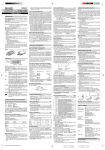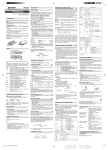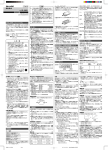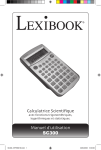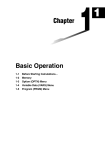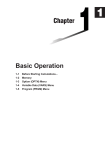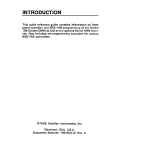Transcript
ENGLISH
SCIENTIFIC
CALCULATOR
EL-509V EL-509VH
MODEL EL-531V EL-531VH
OPERATION MANUAL
PRINTED IN CHINA / IMPRIMÉ EN CHINE
00KUP (TINSK0424THZZ)
INTRODUCTION
About operation examples, please refer to the attached sheet.
Refer to the number on the right of each title for use.
After reading this manual, store it in a convenient location for
future reference.
Note: Some of the models described in this manual may not
be available in some countries.
Operational Notes
To ensure trouble-free operation, please observe the following points:
1. Do not carry the calculator in the back pocket of slacks or
trousers.
2. Do not subject the calculator to extreme temperatures.
3. Do not drop it or apply excessive force.
4. Clean only with a soft, dry cloth.
5. Do not use or store the calculator where fluids can splash
onto it.
♦ Press the RESET switch only in the following cases:
• When using for the first time
• After replacing the batteries
• To clear all memory contents
• When an abnormal condition occurs and all keys are
inoperative.
If service should be required on this calculator, use only a
SHARP servicing dealer, SHARP approved service facility, or
SHARP repair service where available.
Symbol
Equation
Display
Mantissa
8
Exponent
: Appears when the entire equation cannot be displayed. Press </> to see the remaining (hidden) section.
2ndF
: Appears when @ is pressed, indicating that the
functions shown in orange are enabled.
: Indicates that h has been pressed and the hyperbolic functions are enabled. If @ H are
pressed, the symbols “2ndF HYP” appear, indicating that inverse hyperbolic functions are enabled.
ALPHA: Indicates that @ K or O (R) has been
pressed, and entry (recall) of memory contents and
recall of statistics can be performed.
FIX/SCI/ENG: Indicates the notation used to display a value
and changes each time @ f are pressed.
DEG/RAD/GRAD: Indicates angular units and changes each
time G is pressed.
: Appears when statistics mode is selected.
: Indicates that a numerical value is stored in the
independent memory.
Key Notation Used in this Manual
INITIAL SETUP
Mode Selection
x
ln
x
To specify e :
To specify ln :
To specify x :
@e
I
@KX
Power On and Off
Press ª to turn the calculator on, and @F to turn it off.
Clearing Methods
There are three clearing methods as follows:
Clearing
operation
Entry
(Display)
M*1
ª
×
@c
×
A-D, X,Y*2
STAT, ANS
×
Selecting the Display Notation and Decimal Places
: Clear
× : Retain
*1 Independent memory M.
*2 Temporary memories A-D, X and Y, statistical data, and
last answer memory.
Editing the Equation
• Press < or > to move the cursor. You can also
return to the equation after getting an answer by pressing
> (<). See below for Multi-line playback function.
• If you need to delete a number, move the cursor to the
number you wish to delete then press d.
The number under the cursor will be deleted.
• If you need to insert a number, move the cursor to the place
immediately after where you wish to insert the number then
enter the number.
Multi-line Playback function
33333.33333
33333.33333
33333.33
3.33×104
33.33×103
33333.33333
In this calculator, the following three angular units can be
specified.
DEG (°)
Press G
RAD (Radians)
GRAD (g)
(2)
(4)
θ = sin–1 x, θ = tan–1 x
θ = cos–1 x
–90 ≤ θ ≤ 90
0 ≤ θ ≤ 180
π
π
–—≤θ≤—
2
0≤θ≤π
2
–100 ≤ θ ≤ 100
0 ≤ θ ≤ 200
Random Numbers
A pseudo-random number with three significant digits can be
generated by pressing @ ` =. To generate the
next random number, press =. You can perform this function in the normal and statistics modes.
• Random numbers use memory Y. Each random number is
generated on the basis of the value stored in memory Y
(pseudo-random number series).
Angular Unit Conversions
(1)
This calculator is equipped with a function to recall previous
equations. Equations also include calculation ending instructions such as “=” and a maximum of 142 characters can be
stored in memory. When the memory is full, stored equations
are deleted in the order of the oldest first. Pressing [ will
display the previous equation and the answer. Further pressing [ will display preceding equations (after returning to
the previous equation, press ] to view equations in order). In addition, @[ can be used to jump to the oldest
equation.
(6)
This calculator has 6 temporary memories (A-D, X and Y),
one independent memory (M) and one last answer memory.
Independent memory and temporary memories are only available in the normal mode.
[Temporary memories (A-D, X and Y)]
A stored value can be recalled as a value or variable for the
use in equations.
• In case you store an infinite decimal in the memory, recall it
as a variable to obtain accurate answers.
1/3OY
(0.3333...is stored to Y)
3*RY=
3*@KY=
0.999999999
1.
[Independent memory (M)]
In addition to all the features of temporary memories, a value
can be added to or subtracted from an existing memory value.
[Last answer memory (ANS)]
The calculation result obtained by pressing = or any other
calculation ending instruction is automatically stored in the
last answer memory.
Note:
Calculation results from the functions indicated below are
automatically stored in memories X or Y. For this reason,
when using these functions, be careful with the use of memories X and Y.
• Random numbers .................. Y memory
• →rθ, →xy ............................... X memory, Y memory
Temporary memories and last answer memory are cleared
even when the same mode is reselected.
EL-509V(H)/531V(H) (K0424T)_ENGLISH_1
X
Polar coord.
(11)
STATISTICAL CALCULATIONS
Press @ m 1 to select single-variable statistics
mode and @ m 2 to select two- variable statistics
mode. The following statistics can be obtained for each statistical calculation (refer to the table below):
Single-variable statistical calculation
Statistics of
1
Linear regression calculation
1
2
(12)
• Calculation ranges
±10-99 ~ ±9.999999999×1099 and 0.
If the absolute value of an entry or a final or intermediate
result of a calculation is less than 10–99, the value is considered to be 0 in calculations and in the display.
BATTERY REPLACEMENT
Notes on Battery Replacement
Improper handling of batteries can cause electrolyte leakage
or explosion. Be sure to observe the following handling rules:
• Replace both batteries at the same time.
• Do not mix new and old batteries.
• Make sure the new batteries are the correct type.
• When installing, orient each battery properly as indicated in
the calculator.
• Batteries are factory-installed before shipment, and may be
exhausted before they reach the service life stated in the
specifications.
When to Replace the Batteries
If the display has poor contrast, the batteries require replacement.
Caution
• Keep batteries out of the reach of children.
• Exhausted batteries left in the calculator may leak and
damage the calculator.
• Explosion risk may be caused by incorrect handling.
• Batteries must be replaced only with others of the same
type.
• Do not throw batteries into a fire as they may explode.
Replacement Procedure
1.
2.
3.
4.
5.
6.
7.
•
Turn the power off by pressing @ F.
Remove two screws. (Fig. 1)
Slide the battery cover slightly and lift it to remove.
[EL-509V/EL-531V] Remove the used batteries by prying
them with a ball-point pen or other similar pointed device.
(Fig. 2)
[EL-509VH/EL-531VH] Remove used batteries.
Install two new batteries.
[EL-509V/EL-531V] Make sure the “+” side facing up.
[EL-509VH/EL-531VH] First insert the “ – ” side to the
spring. (Fig. 3)
Replace the back cover and screws.
Press the RESET switch (on the back).
Make sure that the display appears as shown below. If the
display does not appear as shown, remove the batteries
reinstall them and check the display once again.
(Fig. 1)
(Fig. 2)
(Fig. 3)
(13)
Statistics of
and
and, in addition, estimate of y for a
given x (estimate y’) and estimate of x for a given y (estimate x’)
2
x
sx
σx
n
Σx
Σx2
y
sy
σy
Σy
Σ y2
Σxy
r
a
b
Mean of samples (x data)
Sample standard deviation (x data)
Population standard deviation (x data)
Number of samples
Sum of samples (x data)
Sum of squares of samples (x data)
Means of samples (y data)
Sample standard deviation (y data)
Population standard deviation (y data)
Sum of samples (y data)
Sum of squares of samples (y data)
Sum of products of samples (x, y)
Correlation coefficient
Coefficient of regression equation (y=a+bx)
Coefficient of regression equation (y=a+bx)
Entered data are kept in memory until @ c or @
m 1 (2) are pressed. Before entering new data,
clear the memory contents.
[Data Entry]
Single-variable data
Data k
Data & frequency k (To enter multiples of the
same data)
Two-variable data
Data x & Data y k
Data x & Data y & frequency k (To enter
multiples of the same data x and y.)
[Data Correction]
Correction prior to pressing k:
Delete incorrect data with ª.
Correction after pressing k:
Press > to confirm the latest entry and press @
J to delete it.
Statistical Calculation Formulas
(14)
Refer also to the operation examples sheet.
In the statistical calculation formulas, an error will occur when:
• the absolute value of the intermediate result or calculation
result is equal to or greater than 1 × 10100.
• the denominator is zero.
• an attempt is made to take the square root of a negative
number.
(5)
Each time @ g are pressed, the angular unit changes
in sequence.
Ex.)
θ
0
In this calculator, all calculation results are internally obtained
in scientific notation with up to 12 digits for the mantissa.
However, since calculation results are displayed in the form
designated by the display notation and the number of decimal
places indicated, the internal calculation result may differ from
that shown in the display. By using the modify function, the
internal value is converted to match that of the display, so that
the displayed value can be used without change in subsequent operations.
(3)
• In the constant calculations, the addend becomes a constant. Subtraction and division are performed in the same
manner. For multiplication, the multiplicand becomes a constant.
• When performing calculations using constants, constants
will be displayed as K.
Functions
X
Modify Function
• The closing parenthesis ) just before = or ;
may be omitted.
Constant Calculations
↔
x
P (r,θ )
r
• The calculation result is automatically stored in memories X
and Y.
Value of r or x: X memory
Value of θ or y: Y memory
SCIENTIFIC CALCULATIONS
Arithmetic Operations
(10)
Y
P (x,y)
y
1
• Press @ m 0 to select the normal mode.
• In each example, press ª to clear the display. And if the
FIX, SCI, or ENG indicator is displayed, clear the indicator
by pressing @ f.
Memory Calculations
RESET
Y
Rectangular coord.
When executing mode selection, temporary memories, statistical data and last answer memory will be cleared even when
reselecting the same mode.
GRAD
(9)
• Before performing a calculation, select the angular unit.
0
Two-variable statistic mode (STAT xy): @m2
Used to perform 2-variable statistical calculations.
RAD
Functions that are printed in orange above the key require
@ to be pressed first before the key. When you specify the
memory, press @K first. Numbers are not shown as
keys, but as ordinary numbers.
Time, Decimal and Sexagesimal Calculations
Single-variable statistics mode (STAT x): @m1
Used to perform 1-variable statistical calculations.
DEG
(8)
This calculator performs arithmetic operations and memory
calculations using a fraction, and conversion between a decimal number and a fraction.
• In all cases, a total of up to 10 digits including integer,
numerator, denominator and the symbol (l) can be entered.
• If the number of digits to be displayed is greater than 10, the
number is converted to and displayed as a decimal number.
• A decimal number, variable, or exponent cannot be used in
a fraction.
Coordinate Conversions
Normal mode (NORMAL): @m0
Used to perform arithmetic operations and function calculations.
In this manual, key operations are described as follows:
(7)
This calculator allows the previous calculation result to be
used in the following calculation.
For example, you can calculate by ⁄= and s=.
The previous calculation result will not be recalled after entering multiple instructions.
Conversion between decimal and sexagesimal numbers can
be performed. In addition, the four basic arithmetic operations
and memory calculations can be carried out using the
sexagesimal system.
• Refer to the operation examples of each function.
• Before starting calculations, specify the angular unit.
• The results of inverse trigonometric functions are displayed
within the following range:
BEFORE USING THE CALCULATOR
e
6
9
Determination of the Angular Unit
/
x
2
5
7
• If the value for floating point system does not fit in the
following range, the calculator will display the result using
scientific notation system:
0.000000001 ≤ | x | ≤ 9999999999
(During actual use not all symbols are displayed at the same
time.)
If the value of mantissa does not fit within the range
±0.000000001 – ±9999999999, the display changes to scientific notation. The display mode can be changed according to
the purpose of the calculation.
STAT
3
100000÷3=
[Floating point]
ª100000/3=
→[Fixed decimal point] @f
[TAB set to 2]
@i 2
→[SCIentific notation]
@f
→[ENGineering notation] @f
→[Floating point]
@f
DISPLAY
M
This calculator performs operations according to the following
priority:
Functions preceded by their argument (x-1, x2, n!, etc.)
Implied multiplication of a memory value (2Y, etc.)
Yx, x¿
Functions followed by their argument (sin, cos, etc.)
Implied multiplication of a function (2sin30, etc.)
nCr, nP r
×, ÷
+, –
=, M+, M–, ⇒M, |DEG, |RAD, |GRAD,
DATA, CD, →rθ, →xy and other calculation ending instruction
• If parentheses are used, parenthesized calculations have
precedence over any other calculations.
1
4
Chain Calculations
Fraction Calculations
Priority Levels in Calculation
The calculator has four display notation systems for displaying calculation results. When FIX, SCI, or ENG symbol is
displayed, the number of decimal places can be set to any
value between 0 and 9. Displayed values will be reduced to
the corresponding number of digits.
Hard Case
HYP
• The multi-line memory is cleared by the following operations: @c, @F (including the Automatic
Power Off feature), mode change, RESET, @`,
@?, constant calculation, angle conversion/change,
coordinate conversion, numerical value storage to the temporary memories and independent memory, and input/deletion of statistical data.
ERROR AND CALCULATION RANGES
Automatic Power Off Function
This calculator will turn itself off to save battery power if no
key is pressed for approximately 10 minutes.
SPECIFICATIONS
Calculations:
Scientific calculations, statistical calculations, etc.
Internal calculations:
Mantissas of up to 12 digits
Pending operations:
16 calculations 8 numeric values
(4 numeric values in STAT mode)
Power source:
3V ¶ (DC):
[EL-509V/EL-531V]
Alkaline batteries (LR44) × 2
[EL-509VH/EL-531VH]
Heavy duty manganese batteries
(size AA or R6) × 2
Power consumption:
0.0006 W
Operating time:
[EL-509V/EL-531V]
Approx. 2500 hours
[EL-509VH/EL-531VH]
Approx. 15000 hours
when continuously displaying 55555.
at 25°C (77°F).
Varies according to use and other
factors.
Operating temperature: 0°C – 40°C (32°F – 104°F)
External dimensions:
[EL-509V/EL-531V]
78.6 mm (W) × 152 mm (D) × 10.5
mm (H)
3-3/32” (W) × 5-31/32” (D) × 13/32”
(H)
[EL-509VH/EL-531VH]
78.6 mm (W) × 166 mm (D) × 19.5
mm (H)
3-3/32” (W) × 6-17/32” (D) × 25/32” (H)
Weight:
[EL-509V/EL-531V]
Approx. 75 g (0.166 lb)
(Including batteries)
[EL-509VH/EL-531VH]
Approx. 115 g (0.254 lb)
(Including batteries)
Accessories:
Batteries × 2 (installed), operation
manual, operation examples sheet,
quick reference card and hard case
Errors
An error will occur if an operation exceeds the calculation
ranges, or if a mathematically illegal operation is attempted.
When an error occurs, pressing < (or >) automatically
moves the cursor back to the place in the equation where the
error occurred. Edit the equation or press ª to clear the
equation.
FOR MORE INFORMATION ABOUT THIS
CALCULATOR
Visit our Web site.
http://sharp-world.com/calculator/
Error Codes and Error Types
Syntax error (Error 1):
• An attempt was made to perform an invalid operation.
Ex. 2 @{
Calculation error (Error 2):
• The absolute value of an intermediate or final calculation result
equals or exceeds 10100.
• An attempt was made to divide by 0.
• The calculation ranges were exceeded while performing calculations.
Depth error (Error 3):
• The available number of buffers was exceeded. (There are 8
buffers* for numeric values and 16 buffers for calculation instructions). *4 buffers in STAT mode.
Equation too long (Error 4):
• The equation exceeded its maximum input buffer (142 characters). An equation must be shorter than 142 characters.
Calculation Ranges
(15)
Refer also to the operation examples sheet.
• Within the ranges specified, this calculator is accurate to ±1
in the least significant digit of the mantissa. When performing continuous calculations (including chain calculations),
errors accumulate leading to reduced accuracy.
1 2 3 4 5 6 7 8 9 0 . ,
1 2 3 4 5 6 7 8 9 0 . ,
1 2 3 4 5 6 7 8 9 0 . ,
1 2 3 4 5 6 7 8 9 0 . ,
1 2 3 4 5 6 7 8 9 0 . ,
1 2 3 4 5 6 7 8 9 0 . ,
